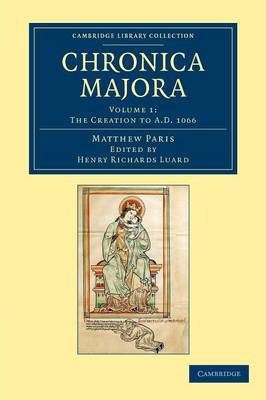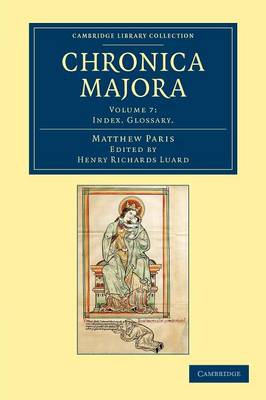Matthaei Parisiensis Chronica majora 7 Volume Set
5 primary works
Volume 1
A Church of England clergyman and fellow of Trinity College, Cambridge, Henry Richards Luard (1825–91) edited a number of works in the Rolls Series, for which he was noted for the quality of his indexing and the depth of his commentary. This seven-volume work, first published between 1872 and 1883, has been hailed as one of the best editions in the series. It is a rich source for English history from the Creation to 1259, written by England's greatest medieval historian. Matthew Paris (c.1200–59) became a monk at St Albans in 1217 and had access to a wide variety of documents as an acquaintance of such men as Bishop Robert Grosseteste and King Henry III, whom he knew well. The Latin text of Volume 1, covering the Creation to 1066, derives mainly from the work of Paris's predecessor, Roger of Wendover.
Volume 4
Matthaei Parisiensis Chronica majora: Volume 4, AD 1240 to AD 1247
by Matthew Paris
Published 15 November 2012
A Church of England clergyman and fellow of Trinity College, Cambridge, Henry Richards Luard (1825-91) edited a number of works in the Rolls Series, for which he was noted for the quality of his indexing and the depth of his commentary. This seven-volume work, first published between 1872 and 1883, has been hailed as one of the best editions in the series. It is a rich source for English history from the Creation to 1259, written by England's greatest medieval historian. Matthew Paris (c.1200-59) became a monk at St Albans in 1217 and had access to a wide variety of documents as an acquaintance of such men as Bishop Robert Grosseteste and King Henry III, whom he knew well. The Latin text of Volume 4, covering 1240-7, includes royal letters, exchequer records and papal documents, alongside vibrant and opinionated passages about taxation and royal extortion.
Volume 5
Matthaei Parisiensis Chronica majora: Volume 5, AD 1248 to AD 1259
by Matthew Paris
Published 15 November 2012
A Church of England clergyman and fellow of Trinity College, Cambridge, Henry Richards Luard (1825-91) edited a number of works in the Rolls Series, for which he was noted for the quality of his indexing and the depth of his commentary. This seven-volume work, first published between 1872 and 1883, has been hailed as one of the best editions in the series. It is a rich source for English history from the Creation to 1259, written by England's greatest medieval historian. Matthew Paris (c.1200-59) became a monk at St Albans in 1217 and had access to a wide variety of documents as an acquaintance of such men as Bishop Robert Grosseteste and King Henry III, whom he knew well. The Latin text of Volume 5 covers the period 1248-59. Given the belief that time would end in 1250, apocalyptic verses conclude the Chronica in that year.
Volume 6
Matthaei Parisiensis Chronica majora: Volume 6, Additamenta
by Matthew Paris
Published 15 November 2012
A Church of England clergyman and fellow of Trinity College, Cambridge, Henry Richards Luard (1825-91) edited a number of works in the Rolls Series, for which he was noted for the quality of his indexing and the depth of his commentary. This seven-volume work, first published between 1872 and 1883, has been hailed as one of the best editions in the series. It is a rich source for English history from the Creation to 1259, written by England's greatest medieval historian. Matthew Paris (c.1200-59) became a monk at St Albans in 1217 and had access to a wide variety of documents as an acquaintance of such men as Bishop Robert Grosseteste and King Henry III, whom he knew well. Volume 6 is an appendix to the chronicle. It comprises a broad selection of illustrative Latin documents of particular relevance to Paris's monastery, including Henry's confirmation of Magna Carta.
Volume 7
A Church of England clergyman and fellow of Trinity College, Cambridge, Henry Richards Luard (1825–91) edited a number of works in the Rolls Series, for which he was noted for the quality of his indexing and the depth of his commentary. This seven-volume work, first published between 1872 and 1883, has been hailed as one of the best editions in the series. It is a rich source for English history from the Creation to 1259, written by England's greatest medieval historian. Matthew Paris (c.1200–59) became a monk at St Albans in 1217 and had access to a wide variety of documents as an acquaintance of such men as Bishop Robert Grosseteste and King Henry III, whom he knew well. Volume 7 contains a comprehensive index, a glossary, and errata and addenda.


